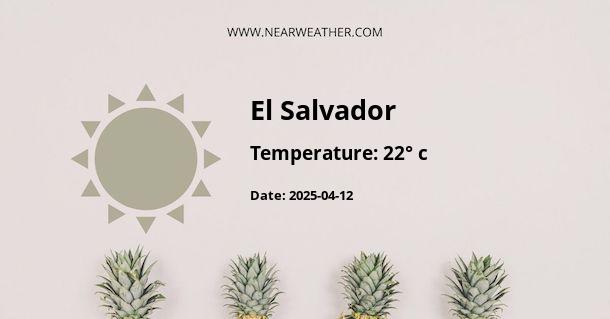Climate and Weather in El Salvador
El Salvador, located in Central America, has a tropical climate that is influenced by its proximity to the equator and the Pacific Ocean. The weather throughout the year is characterized by distinct wet and dry seasons, with variations in temperature and rainfall depending on the region and altitude.
Seasonal Overview
El Salvador experiences two main seasons: the dry season, known as "verano" (summer), and the rainy season, known as "invierno" (winter). The dry season typically runs from November to April, while the rainy season occurs from May to October. The transition months of October and November can experience some rainfall as well.
Dry Season (November to April)
During the dry season, El Salvador experiences low precipitation and warm temperatures. The lack of rainfall results in dry and arid conditions across the country, making it an ideal time for outdoor activities and tourism. The average temperatures range from 25°C to 30°C (77°F to 86°F) in the lowlands, with cooler temperatures in the highlands.
Rainy Season (May to October)
The rainy season brings abundant precipitation to El Salvador, with the highest rainfall occurring in the central and eastern regions of the country. The average temperatures during this period are slightly lower, ranging from 22°C to 28°C (72°F to 82°F) in the lowlands.
Temperature Variation
Temperature variations in El Salvador are influenced by altitude, with coastal areas experiencing warmer temperatures than the inland regions. The average annual temperature in the lowlands is around 25°C (77°F), while higher elevations can have cooler average temperatures of 20°C (68°F).
Climate by Region
El Salvador's climate varies by region, with the coastal areas having a tropical climate and the interior regions experiencing a more temperate climate due to higher elevations. The northern part of the country tends to be warmer and receives less rainfall compared to the central and eastern regions.
Extreme Weather Events
El Salvador is susceptible to natural disasters such as hurricanes, earthquakes, and volcanic eruptions. The country's vulnerability to these events is a result of its geographical location and topography.
Hurricanes
El Salvador is located in the path of hurricanes that originate in the Caribbean Sea and the Pacific Ocean. These powerful storms can bring heavy rainfall, strong winds, and flooding, particularly during the rainy season.
Earthquakes and Volcanic Activity
El Salvador is part of the Pacific Ring of Fire, making it prone to seismic activity and volcanic eruptions. The country has experienced significant earthquakes in the past, which have had devastating effects on its infrastructure and population.
Weather Affecting Tourism
The climate in El Salvador plays a significant role in influencing tourism patterns. The dry season, with its warm and sunny weather, is the preferred time for tourists to visit the country and explore its natural beauty, including pristine beaches, national parks, and archaeological sites.
Conclusion
El Salvador's climate is characterized by distinct wet and dry seasons, with variations in temperature and rainfall influenced by its geographical features. Understanding the climate and weather patterns is essential for both residents and tourists to adequately prepare for the conditions and potential natural hazards that may occur throughout the year.
A - El Salvador's Latitude is 13.833330 & Longitude is -88.916672.
A - Weather in El Salvador is 22° today.
A - Climate Conditions in El Salvador shows overcast clouds today.
A - Humidity in El Salvador is 69% today.
A - Wind speed in El Salvador is 5.58 km/h, flowing at 314° wind direction. today.
